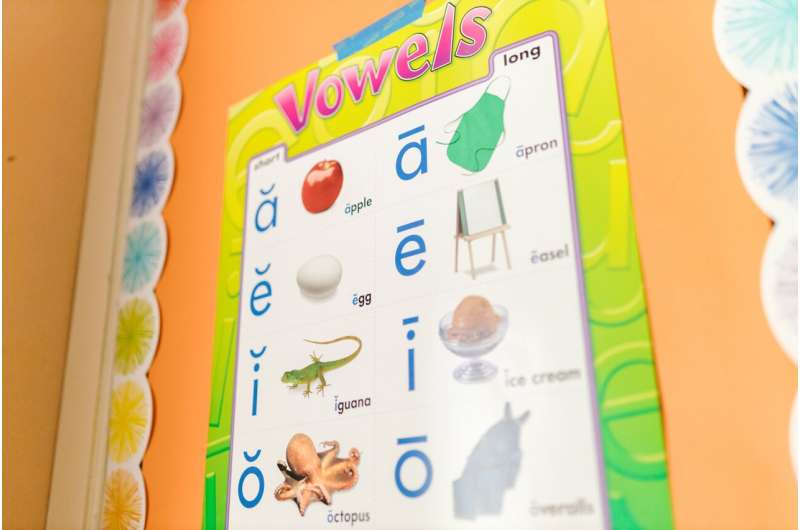This article has been reviewed according to Science X's editorial process and policies. Editors have highlighted the following attributes while ensuring the content's credibility:
fact-checked
trusted source
proofread
New research shows extra practice in blending letter sounds helps struggling readers

New research at Aston University has shown that extra practice in blending printed letter sounds can help struggling beginner readers in reception classes learn to read.
The paper is published in the British Journal of Educational Psychology.
Children in England learn to read through a system known as synthetic phonics, where they are taught the sounds of letters, "phonemes," and how these sounds are written, "graphemes." For example, "my" and "lie" have the same phoneme at the end, but different graphemes.
Pupils learn to identify graphemes, match them with phonemes, and blend the phonemes together to form the sound of the complete words (for example c-a-t = "k—æ—t" = "cat"). This is known as blending. To learn successfully in this way, children need letter sound knowledge (LSK)—awareness of the sounds represented by letters/graphemes—and phonological awareness (PA)—the awareness of individual sounds in words.
While the use of phonics has been shown to increase reading attainment in children, many teachers are not sure what additional support is most beneficial for those who are still struggling. They will often give extra LSK training using flashcards showing each letter or letter combination.
The new research, led by Dr. Laura Shapiro in the School of Psychology, shows that extra training on how to blend printed letter sounds is most beneficial because this type of training had the biggest impact on PA, which is an essential skill for learning to read.
The researchers worked with teachers to identify children struggling with reading and recruited 222 children from 12 primary schools for the study, working with each child for half a term.
The researchers compared three key components of early reading—sounding out printed letters, blending the sounds out loud, and both sounding out and blending printed letter sounds. In each session, the researchers showed the children one word at a time, without a picture or sentence context, to allow the child to focus on the target word. After the child was helped to read the word, they were shown an illustration relating to the word and a related sentence was read out loud to them. This context made the task enjoyable and meaningful and often prompted chats and interaction.
Dr. Shapiro said, "Many teachers already give extra support to struggling readers in reception, and often give support on learning letter sounds. Although practice on letter sounds is helpful, our study suggests it is more beneficial to give children extra practice in sounding out the letters AND blending the sounds together to make a word."
The researchers carefully controlled the conditions of the study to identify exactly which component of reading it was most crucial to support. The training used the same standardized instructions, pictures, and context sentences, with only the focus of the training changing.
Dr. Shapiro says that they will now work with teachers to develop a strategy suitable for the classroom. Together, they will identify the most practical and enjoyable ways to provide PA support to children and develop effective strategies that can be shared for other teachers to use and adapt.
Dr. Shapiro has this advice for teachers and parents: "Help children to practice blending the sounds in words, such as 'm-u-ch' makes 'much,' and do this while pointing at the letters in the printed word so that they can see the connection between the letters, their sounds and the blended word. Children enjoyed seeing the word put into context with a picture and a fun sentence. It helps to keep the reading part simple, for example, show them just one word and hide the rest of the page and the picture. Then once you've supported them to sound this word out, show the picture, read the remainder out loud and give them an opportunity to talk about the story."
More information: Charlotte Webber et al, An experimental comparison of additional training in phoneme awareness, letter‐sound knowledge and decoding for struggling beginner readers, British Journal of Educational Psychology (2023). DOI: 10.1111/bjep.12641
Provided by Aston University





















